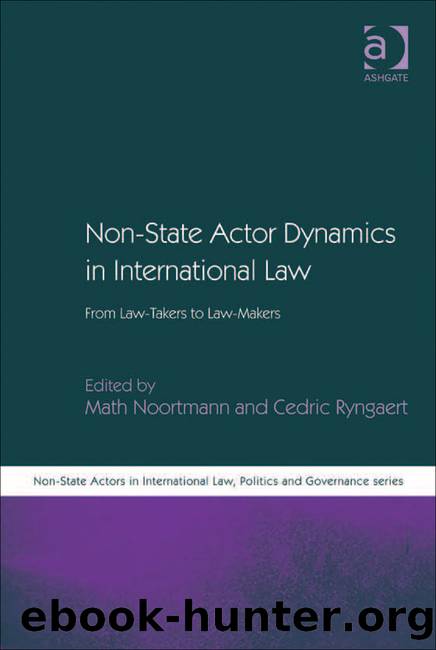Non-state Actor Dynamics in International Law by Ryngaert Cedric. Noortmann Math. & Cedric Ryngaert

Author:Ryngaert, Cedric.,Noortmann, Math. & Cedric Ryngaert
Language: eng
Format: epub
Publisher: Taylor & Francis (CAM)
Published: 2010-11-15T00:00:00+00:00
âSoftâ International Legal Personality
Outside the âlaw as processâ school, certainly softness of international law is also an issue. The end of the binary opposition between international law as a system of âhardâ rules on the one hand and âsoftâ international law on the other (Chinkin 1989: 850â866), arguably leaves room also for a softer (version of) ILP. The general idea then is that for actors to be addressed by soft international norms, to be involved in the creation of soft law instruments, etc., may not be enough to have full-fledged ILP in international law â yet it stands for something. âSoft international legal personalityâ may then express the âexistenceâ of a particular actor in the eyes of international soft law instruments. In other words, it is not so much a fundamental adaptation of the definition of ILP as it is an implication of the growing âsoftness in international lawâ (dâAspremont 2008) for the ILP conception. While Jean dâAspremont is right that the binary nature of law is worth fighting for, I beg to differ on the point of his explanation for the softening of international law. In this case, the introduction of a softer version of ILP for NSAs means a more adequate description of a serious normative development, that is to say, soft law that addresses NSAs (Shelton 2009, also Chinkin 2000). It is not âan artificial extension of the frontiers of international lawâ for the sake of mere scholarly pleasure (dâAspremont 2008). It is worth developing our terminology so as to encompass also softer tones of âlegalnessâ and recognize that international law can have normative force also for actors which are not formally bound by a particular international norm, yet sometimes willing to comply; or that international normativity can be shaped by international documents which escape the binary structure of law, such as non-binding documents of international organizations, codes of conduct, private governance arrangements. A soft ILP notion would thus accommodate and recognize the new role of NSAs within the international legal system. Otherwise they are left with an unclear, controversial status within a global legal arena that will become only more complex and plural.
Obviously, on the one hand softening ILP is an inclusive exercise. It may serve to rescue ILP from the positivist, binary understanding of international law and contribute to its adaptation to new legal phenomena. On the other hand, softened ILP confirms to some extent the validity of Higginsâ critique of how our discipline has âerected an intellectual prisonâ that obstructs the adaptation of international law to the social reality. Alston has uttered similar critique with his âNot-a-Catâ image (Alston 2005: 3â4, 19â20); the use of the term ânon-state actorsâ is in itself an intentional technique to exclude these actors from the international legal system. Behind our disciplineâs terminology functions the exclusive club or âcatalogueâ approach to ILP (see also, Alston 2005: 19, Clapham 2006: 70â71: âdoctrinal filtersâ, Brölmann 2007a: 69â70), which stands in the way of inclusion. Against the backdrop of the traditional approach
Download
This site does not store any files on its server. We only index and link to content provided by other sites. Please contact the content providers to delete copyright contents if any and email us, we'll remove relevant links or contents immediately.
| Anthropology | Archaeology |
| Philosophy | Politics & Government |
| Social Sciences | Sociology |
| Women's Studies |
Cecilia; Or, Memoirs of an Heiress — Volume 1 by Fanny Burney(32434)
Cecilia; Or, Memoirs of an Heiress — Volume 2 by Fanny Burney(31868)
Cecilia; Or, Memoirs of an Heiress — Volume 3 by Fanny Burney(31852)
The Great Music City by Andrea Baker(31327)
We're Going to Need More Wine by Gabrielle Union(18967)
All the Missing Girls by Megan Miranda(15562)
Pimp by Iceberg Slim(14379)
Bombshells: Glamour Girls of a Lifetime by Sullivan Steve(13972)
Talking to Strangers by Malcolm Gladwell(13222)
Norse Mythology by Gaiman Neil(13204)
Fifty Shades Freed by E L James(13157)
For the Love of Europe by Rick Steves(12927)
Mindhunter: Inside the FBI's Elite Serial Crime Unit by John E. Douglas & Mark Olshaker(9186)
Crazy Rich Asians by Kevin Kwan(9167)
The Lost Art of Listening by Michael P. Nichols(7403)
Enlightenment Now: The Case for Reason, Science, Humanism, and Progress by Steven Pinker(7228)
The Four Agreements by Don Miguel Ruiz(6622)
Bad Blood by John Carreyrou(6543)
Weapons of Math Destruction by Cathy O'Neil(6142)
